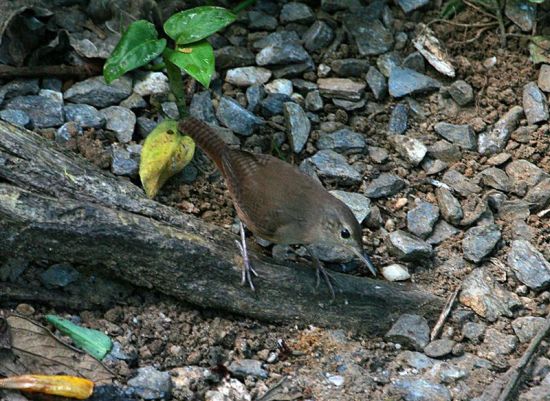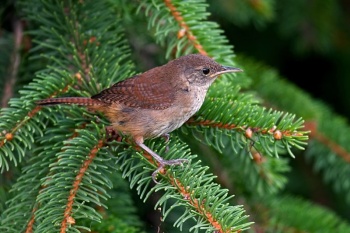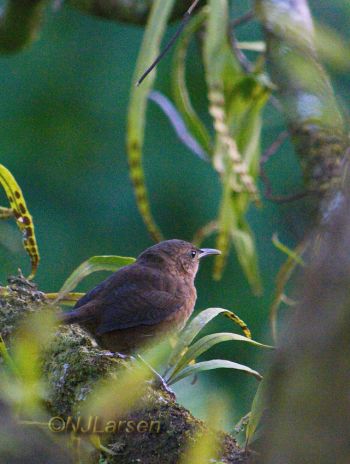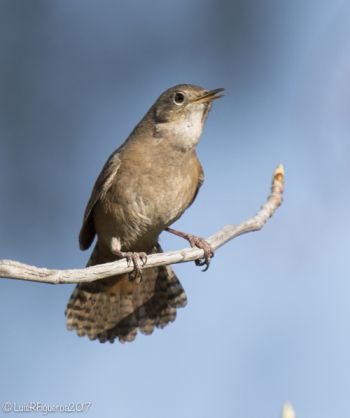- Troglodytes aedon
Identification
Length 11.5-12.5 cm, weight 9-14 g.
- Small bird
- Short tail, often held cocked over the back
- Dusky brown above
- Paler below, with no distinctive markings
Similar Species
Winter Wren and Pacific Wren are similar but smaller and darker, with shorter tail and pale eyebrow.
Distribution
Throughout South America and the southern half of North America. As discussed below, there are four main groups within House Wren, which are treated as full species by some authorities1.
- Northern House Wren: breeds in much of the United States and southernmost parts of Canada; members of this groups are at least partly migratory.
- Brown-throated Wren: mainly a Mexican grouping, but also found in southeastern Arizona and southwestern New Mexico.
- Southern House Wren: much of Central and South America.
- Caribbean House Wren: several islands in the Lesser Antilles and Cozumel off Mexico (possibly even with one species per island).
Taxonomy
Clements2 accepts more than 30 subspecies of House Wren. There has been several suggestions about splitting this species into several species, with the approximate divisions given in the Distribution section above. The taxonomic status of House Wren have been discussed elsewhere in Birdforum3 and there are indications that the northern group may need to be split into an eastern and western form.
Cobb's Wren and Clarion Wren were formerly included in this species; their current treatment as separate species leaves Troglodytes aedon sensu lato as very probably paraphyletic.
Subspecies
There are 32 subspecies[1]:
Northern House Wren (Troglodytes aedon sensu stricto, when treated as a species)
- T. a. parkmanii: South-western Canada to central and western US and northern Baja California
- T. a. aedon: South-eastern Canada and eastern US
- T. a. baldwini: South-central Canada to southern US
Brown-throated Wren (Troglodytes brunneicollis, when treated as a species)
- T. a. cahooni: Mountains of south-eastern Arizona to central Mexican plateau
- T. a. brunneicollis: Central and southern Mexico (San Luis Potosí and Hidalgo to Oaxaca)
- T. a. compositus: Mountains of eastern Mexico (Coahuila and Nuevo León to Puebla)
- T. a. nitidus: Southern Mexico (Mount Zempoaltepec in Oaxaca)
Caribbean House Wren (possibly one species per island)
- T. a. rufescens: Dominica (Lesser Antilles)
- T. a. martinicensis: Martinique (Lesser Antilles)
- T. a. mesoleucus: St. Lucia (Lesser Antilles)
- T. a. guadeloupensis: Guadeloupe (Lesser Antilles)
- T. a. musicus: St. Vincent (Lesser Antilles)
- T. a. grenadensis: Grenada (Lesser Antilles)
- T. a. beani: Eastern Mexico (Cozumel Island off Quintana Roo)
Southern House Wren (Troglodytes musculus, when treated as a species)
- T. a. intermedius: Southern Mexico (south-eastern Oaxaca and eastern Tabasco) to Costa Rica
- T. a. inquietus: Extreme southern Costa Rica, Panama and Pearl Islands
- T. a. carychrous: Coiba Island (Panama)
- T. a. clarus: Trinidad, the Guianas, Venezuela, Brazil, northern Peru, Colombia
- T. a. atopus: Northern Colombia (Santa Marta region)
- T. a. striatulus: Western and Central Andes of Colombia
- T. a. columbae: Eastern Colombia and western Venezuela
- T. a. albicans: South-Western Colombia and western Ecuador
- T. a. tobagensis: Tobago
- T. a. audax: Arid littoral of western Peru (Cajamarca to northern Ica)
- T. a. puna: Puna of northern Peru to north-western Bolivia (La Paz)
- T. a. rex: Central and eastern Bolivia
- T. a. carabayae: Central and southern Peru (Junín, Cusco and Puno)
- T. a. tecellatus: Coastal southern Peru (Arequipa) to northern Chile (Tarapacá)
- T. a. atacamensis: Northern Chile (Antofagasta, Atacama and northern Coquimbo)
- T. a. musculus: Central and southern Brazil to eastern Paraguay and northeastern Argentina (Misiones)
- T. a. bonariae: Southern Brazil, Uruguay and northeastern Argentina
- T. a. chilensis: Southern Chile and southern Argentina to Tierra del Fuego
Habitat
Residential areas, city parks, farmlands, and woodland edges.
Behaviour
Breeding
The nest is cup shaped, made of sticks, grass and lined with feathers. 5-8 white, brown-speckled eggs are laid.
Vocalisation
Song is very variable among the different populations, but normally relatively standard within each population. In the USA often first rising, then falling, and often described as having a bubbling quality.
Recording by NJLarsen in Dominica. Bird is subspecies T. a. rufescens
Recording by NJLarsen in Rancho Naturalista, Costa Rica. Bird is subspecies T. a. intermedius
References
- Del Hoyo, J, A Elliot, and D Christie, eds. 2005. Handbook of the Birds of the World. Volume 10: Cuckoo-Shrikes to Thrushes. Barcelona: Lynx Edicions. ISBN 978-8487334726
- Clements, J. F., T. S. Schulenberg, M. J. Iliff, D. Roberson, T. A. Fredericks, B. L. Sullivan, and C. L. Wood. 2017. The eBird/Clements checklist of birds of the world: v2017, with updates to August 2017. Downloaded from http://www.birds.cornell.edu/clementschecklist/download/
- Second half of this thread was mostly about House Wren taxonomy
- Birdforum thread discussing Cobb's Wren
Recommended Citation
- BirdForum Opus contributors. (2025) House Wren. In: BirdForum, the forum for wild birds and birding. Retrieved 29 April 2025 from https://www.birdforum.net/opus/House_Wren
External Links
GSearch checked for 2020 platform.1







